by W.S. Cranshaw and F.B. Peairs 1 (12/08)
Quick Facts…
- Indian meal moth, flour beetles, sawtoothed grain beetles and carpet beetles (dermestids) are common pests of food items in Colorado homes.
- When insects that infest food are first detected, try to identify all sources of infestation.
- To control infestations, use sanitary measures that remove food for the developing insects.
- Cold treatments can kill insects in food items.
- When using insecticides in and around food storage areas, never allow chemicals to directly contact the food.
Several insects commonly infest home-stored foods in Colorado, such as grains, flour, nuts, spices, packaged herbs and dried fruit. If infestations are prolonged, foods may be seriously damaged and may need to be discarded. Many people will discard food products that are even lightly infested by insects. These insects typically pose little health hazard, although some species (notably carpet beetles), can produce irritation or allergic reactions.
Indian meal moth, flour beetles and sawtoothed grain beetles are particularly common in Colorado homes and are found throughout most of the world. Sometimes insects that infest food, such as: carpet beetles, enter homes through natural migrations. More often, insects enter homes on food already infested during storage or transportation.
Description
 |
| Figure 1: Flour beetle. |
Flour Beetles
Flour most commonly is infested by either of two closely related beetles, the confused flour beetle and the red flour beetle (Tribolium, Figure 1). Small pieces of cracked grains also may be sources of flour beetle infestation.
The adult flour beetles are reddish-brown and less than 1/8 inch long. They are sometimes called “bran bugs” because they are so common in milling operations. Both species of flour beetles have wings but rarely fly.
Immature stages are pale-colored and wormlike. On close inspection, a pair of pointed forks can be seen on the hind body segment. Development of the immature stage typically takes one to two months and adults lay eggs over a period of five to eight months. Both adult and immature stages feed on flour.
Sawtoothed Grain Beetle
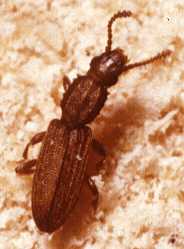 |
| Figure 2: Sawtoothed grain beetle. |
The sawtoothed grain beetle (Oryzaephilus surinamensis) is the most common beetle found infesting household food in Colorado. It can develop in flour, but most infestations occur in processed grain products such as breakfast cereals, oatmeal, corn meal and pasta. Dried fruit and chocolate also may be infested.
The adult beetle (Figure 2) is about 1/10 inch long, similar in size to the flour beetles. It is elongate in body shape, flattened, and distinctively marked with a series of saw-like projections along the sides of the thorax. However, because of its small size, some magnification may be needed to detect these characteristics. Sawtoothed grain beetles have wings, but have never been observed to fly.
Eggs are laid in crevices in the food supply. The larvae are yellowish-white with a dark head and worm-like shape. Larvae feed on the same foods as adults. Under optimal conditions, they can complete a generation in less than two months. Adult beetles may live for a year or more.
Carpet Beetles
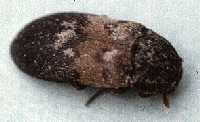 |
| Figure 3: Larder beetle. |
Several species of carpet beetles (Dermestidae) (Figure 3) occur indoors and outdoors in Colorado. They have extremely diverse feeding habits but prefer high-protein materials of animal origin, such as wool and skins. Household lint, dead insects or other debris are common materials on which large numbers of carpet beetles may breed. (See fact sheet 5.549, Carpet Beetles.)
Infestations of carpet beetles in pantries are less common than for flour or sawtoothed grain beetles. Carpet beetles are relatively slow to develop. On cereal products, they require about one year for a generation. However, because the insects are highly mobile, infestations may reoccur annually.
Carpet beetles are much more important as pests of woolens, furs and other materials of animal origin. They are far more common and damaging to fabrics than clothes moths in Colorado.
Spider Beetles
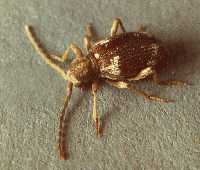 |
| Figure 4: Spider beetle. |
Spider beetles (Ptinidae) (Figure 4) are a relatively rare pest of stored food in Colorado. They are larger than the other common stored-products beetles and appear similar in shape to a spider. However, spider beetles have three pairs of legs, which distinguishes them from the eight-legged true spiders.
Spider beetles can potentially infest a wide variety of animal or vegetable products. They are most commonly associated with grains, although they can eat feathers, wool, dried meat and other products. Infestations mostly occur when these foods have been moistened and begun to mold.
Eggs of the spider beetles are white and may be conspicuously laid about the food products. The larvae are C-shaped and resemble small white grubs. Pupation of spider beetles often occurs in small cavities that they chew out of wood or other soft materials.
Indian Meal Moth
The Indian meal moth (Plodia interpunctella) is a common insect found infesting food products in Colorado homes. Almost any coarse grains (oatmeal, grits, etc.), nuts, seeds, dried pet foods, candy bars, spices, cocoa, dried fruits or vegetables (e.g., chilis) are suitable materials for Indian meal moth development. However, flour is rarely infested.
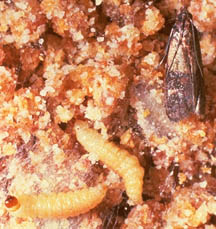 |
| Figure 5: Indian meal moth adult and larvae. |
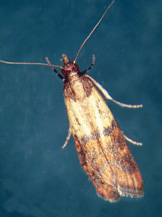 |
| Figure 6: Indian meal moth. |
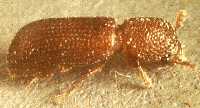 |
| Figure 7: Lesser grain borer. |
The adult stage of the Indian meal moth (Figure 5) is about 1/2 inch long and generally gray with bronze wing tips. The moth is the most common small moth found flying in Colorado homes. Feeding damage is done by the larvae (“worms”), which are usually pale yellow to pink with a dark head. When feeding, the larvae produce webbing that is mixed with food particles and droppings.
Indian meal moths occur throughout the United States and most household infestations originate from the inadvertent purchase of infested products. During warm months, localized movements of the moths also may occur outdoors, resulting in household infestations. Because of the broad distribution of the insect, it is rarely possible to definitely establish the original source of a meal moth infestation unless detected at purchase.
Adult moths lay eggs near suitable food, such as along cracks or folds of packages. The newly hatched larvae are small and can penetrate loosely-closed packaging. When they reach a suitable food, they begin to feed. Development can be rapid under favorable conditions, and the larvae ultimately grow to about 1/2 inch long. Pupation occurs and the adult moths emerge. Adult female moths can lay 200 to 400 eggs during their lifetime of several weeks. Complete development of the Indianmeal moth varies due to temperature and food but typically requires at least one month. (See 5.598, Indian Meal Moth)
Insects Infesting Whole Grains
Several species of beetles can infest whole (unmilled) grains and beans. Among the more common of these “direct pests” is the lesser grain borer (Figure 6), which develops by tunneling kernels of wheat and other small grains. Other types of beetles infest seeds of corn, rice, beans or other items.
Although relatively infrequent in homes, these insects can cause serious losses to bulk-stored grains. They also produce grain particles that allow other insects, such as the sawtoothed grain beetle, to become established in a food storage area.
Control
When insects are first detected in food products, try to identify all sources of infestation in the home. Check all susceptible food items in cupboards. Pay particular attention to items that have not been used for a long time. Also check areas of spilled foods.
If you know the identity of the insect, it will help you focus your search. If flour beetles are present, look only through finely-milled materials including crumbs and other spilled material. Sawtoothed grain beetles may infest a wider range of food, including oatmeal and coarsely milled
food. Indian meal moths or cockroaches infest pet food or bird seed and other ornamental items that involve the use of grains or dried fruits and vegetables. Carpet beetles most typically are established in woolens, furs, among dead insects and household lint.
The physical presence of the insects is the most obvious means of detecting areas of infestation. Also look for old cast skins left by flour and carpet beetles. The presence of webbing is an easy means to detect items infested by Indian meal moth.
Items infested by insects that live within the food (carpet beetles, flour beetles or Indian meal moth) should immediately be discarded or temperature treated to kill the insect. To control with cold treatment, put infested items in a deep freeze for three to four days. To improve the effectiveness of this treatment, alternate freezing treatments with a period of rewarming to room temperature. For high temperature treatments, heat the oven around 133 to 140 degrees F, introduce the food items and hold for 20 minutes. Injury to the food is possible with excessive high
temperature treatment.
Heat- or cold-treated objects can be reinfested. Keep them in the refrigerator or store them in tight-fitting containers until household infestations are eliminated. Adult Indian meal moths and flour beetles deprived of food might live three to five weeks. Carpet beetle and cockroach infestations typically take much longer to eradicate. Because insects also can develop on spilled food, thoroughly clean areas where food is stored by vacuuming or sweeping all spilled food. Bleach or other sanitizing agents often are used during this cleanup phase but have little effect. These agents can kill a few exposed insects and eggs, but have no residual effect unless spilled foods are completely eliminated.
As a routine precaution, materials suspected of having insects can be treated by freezing after purchase. Purchase smaller amounts of food and use food products directly after purchase to prevent infestations from being established by insects brought in on the food.
Use of insecticides within the pantry area is not generally recommended and normally will give little additional control in the absence of an aggressive sanitation program. Some household formulations of pyrethrins are labeled for use as crack and crevice treatments near food storage
areas. There are also some formulations of pyrethroid insecticides (bifenthrin, permethrin, and tralomethrin) that allow general use in the home and may help manage insects that are widely dispersed.Never apply insecticides in a manner that allows direct contact with food or food utensils. Often it is best to remove all food and utensils during insecticide treatment to avoid accidental contamination.
Because of the diverse feeding habits and mobility of pests such as cockroaches and carpet beetles, controls must take place over a larger area of the home.
Always read and follow label directions when using pesticides! This is particularly important when direct treatments are made around foodstuffs or food handling areas. Only products labeled specifically for use around food storage areas may be used for controlling insect pests around areas where food is stored.
When using insecticides in the home:
- Properly store insecticides within a home.
- Purchase only the amount of insecticide you intend to use.
- Store insecticides and other pesticides out of reach of children or pets.
- Store pesticides away from heat or high moisture.
- Never store pesticides with food or food utensils.
- Properly dispose of pesticides as indicated on the label or according to local regulations on hazardous waste disposal.
1 Colorado State University Extension entomologists and professors, bioagricultural sciences and pest management. 3/96. Revised 12/08.
Go to top of this page.





